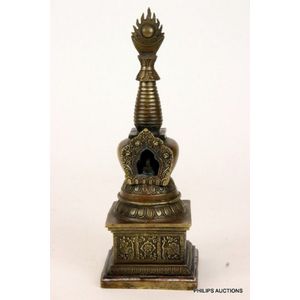Gilt Bronze Sino-Tibetan Stupa Shrine, 19th Century
A Sino-Tibetan gilt bronze Stupa shrine, 19th century, the finely cast gilt bronze reliquary on a waisted square section decorated in relief with confronted lions, below a domed stupa accommodating an image of Buddha set within an arched niche framed by flame scrolls, with square harmika, tapering slender spire and crescent moon and sun finial, inscribed to the underside with dedicatory verses, height 25.5 cm
You must be a subscriber, and be logged in to view price and dealer details.
Subscribe Now to view actual auction price for this item
When you subscribe, you have the option of setting the currency in which to display prices to $Au, $US, $NZ or Stg.
This item has been sold, and the description, image and price are for reference purposes only.
- Finial - An architectural decoration, found on the upper parts of of an object. On furniture they are usually found on pediments, canopies and shelf supports. On smaller ceramic or silver items, such as spoons, they may decorate the top of the item itself, or the lid or cover where they provide a useful handle for removal.
Finials have a variety of shapes and forms. They may be urn-shaped, baluster shaped round or spiral, but usually taper into an upper point. Many real life shapes may also be used as finials, such as pineapples, berries, pinecones, buds, lotus and acorns. Sometimes animals such as a lion are depicted, or fish and dolphins. - Bronze - An alloy of copper and tin, traditionally in the proportions of about 9 parts of copper to 1 part of tin.
The discovery of bronze in Western Asia in the 4th century enabled people to create metal objects which were superior to those previoulsy possible because of its strength and hardness, and it has been used throughout the world for weapons, coins, tools, statuary and other decorative items.
It is very fluid in a molten state, and its hardness, strength when set, and non-corrosive properties makes it most suitable for casting sculpture.
This item has been included into following indexes:
- Oriental deities, other materials - Buddha 622
- Oriental deities, Tibetan and Sino-Tibetan - Buddha and other deities 271
- religious objects, oriental
